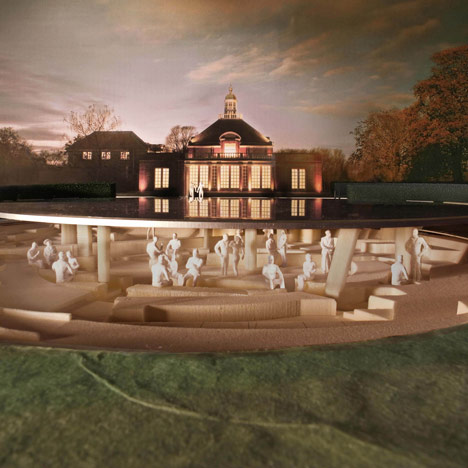The Serpentine Gallery in London has unveiled plans by Swiss architects Herzog & de Meuron and Chinese artist Ai Weiwei for this summer's Serpentine Gallery Pavilion: they'll conduct an archaeological dig to find traces of past pavilions on the site then line the resulting trenches with cork.
The plan involves excavating down to groundwater level, revealing buried traces of the past eleven annual pavilions and creating a well at the bottom that will also collect rainwater.
A pool of water will also cover the surface of the circular roof, supported just 1.4 metres above the ground by twelve columns that represent pavilions past and present. It will be possible to drain this water down into the well to create an elevated viewing platform or dance floor.
The temporary pavilion will open to the public on 1 June and will remain in Kensington Gardens until 14 October.
The twelfth annual pavilion follows previous structures by architects including Peter Zumthor, Jean Nouvel, SANAA and Frank Gehry. You can see images of them all here, watch our interview with Peter Zumthor at the opening of last year’s pavilion on Dezeen Screen and read even more about the pavilions in our Dezeen Book of Ideas.
See also: more stories about Herzog & de Meuron and more stories about Ai Weiwei.
Here's some more information from the Serpentine Gallery:
Serpentine Gallery reveals plans for Pavilion designed by Herzog & de Meuron and Ai Weiwei
The Serpentine Gallery today released plans for the 2012 Serpentine Gallery Pavilion designed by Herzog & de Meuron and Ai Weiwei. It will be the twelfth commission in the Gallery’s annual series, the world’s first and most ambitious architectural programme of its kind.
The design team responsible for the celebrated Beijing National Stadium, which was built for the 2008 Olympic Games, comes together again in London in 2012 for the Serpentine’s acclaimed annual commission, being presented as part of the London 2012 Festival, the culmination of the Cultural Olympiad. The Pavilion is Herzog & de Meuron and Ai Weiwei’s first collaborative built structure in the UK.
This year’s Pavilion will take visitors beneath the Serpentine’s lawn to explore the hidden history of its previous Pavilions. Eleven columns characterising each past Pavilion and a twelfth column representing the current structure will support a floating platform roof 1.4 metres above ground. The Pavilion’s interior will be clad in cork, a sustainable building material chosen for its unique qualities and to echo the excavated earth. Taking an archaeological approach, the architects have created a design that will inspire visitors to look beneath the surface of the park as well as back in time across the ghosts of the earlier structures.
Julia Peyton-Jones, Director, and Hans Ulrich Obrist, Co-Director, Serpentine Gallery, said: “It is a great honour to be working with Herzog & de Meuron and Ai Weiwei, the design team behind Beijing’s superb Bird’s Nest Stadium. In this exciting year for London we are proud to be creating a connection between the Beijing 2008 and the London 2012 Games. We are enormously grateful for the help of everyone involved, especially Usha and Lakshmi N. Mittal, whose incredible support has made this project possible.”
The Serpentine Gallery Pavilion will operate as a public space and as a venue for Park Nights, the Gallery’s high-profile programme of public talks and events. Connecting to the archaeological focus of the Pavilion design, Park Nights will culminate in October with the Serpentine Gallery Memory Marathon, the latest edition of the annual Serpentine Marathon series conceived by Hans Ulrich Obrist, now in its seventh year. The Marathon series began in 2006 with the 24-hour Serpentine Gallery Interview Marathon; followed by the Experiment Marathon in 2007; the Manifesto Marathon in 2008; the Poetry Marathon in 2009, the Map Marathon in 2010 and the Garden Marathon in 2011.
The 2012 Pavilion has been purchased by Usha and Lakshmi N. Mittal and will enter their private collection after it closes to the public in October 2012.

